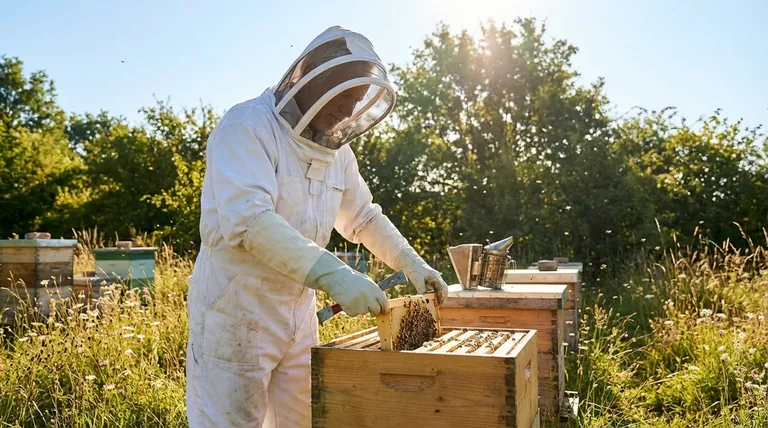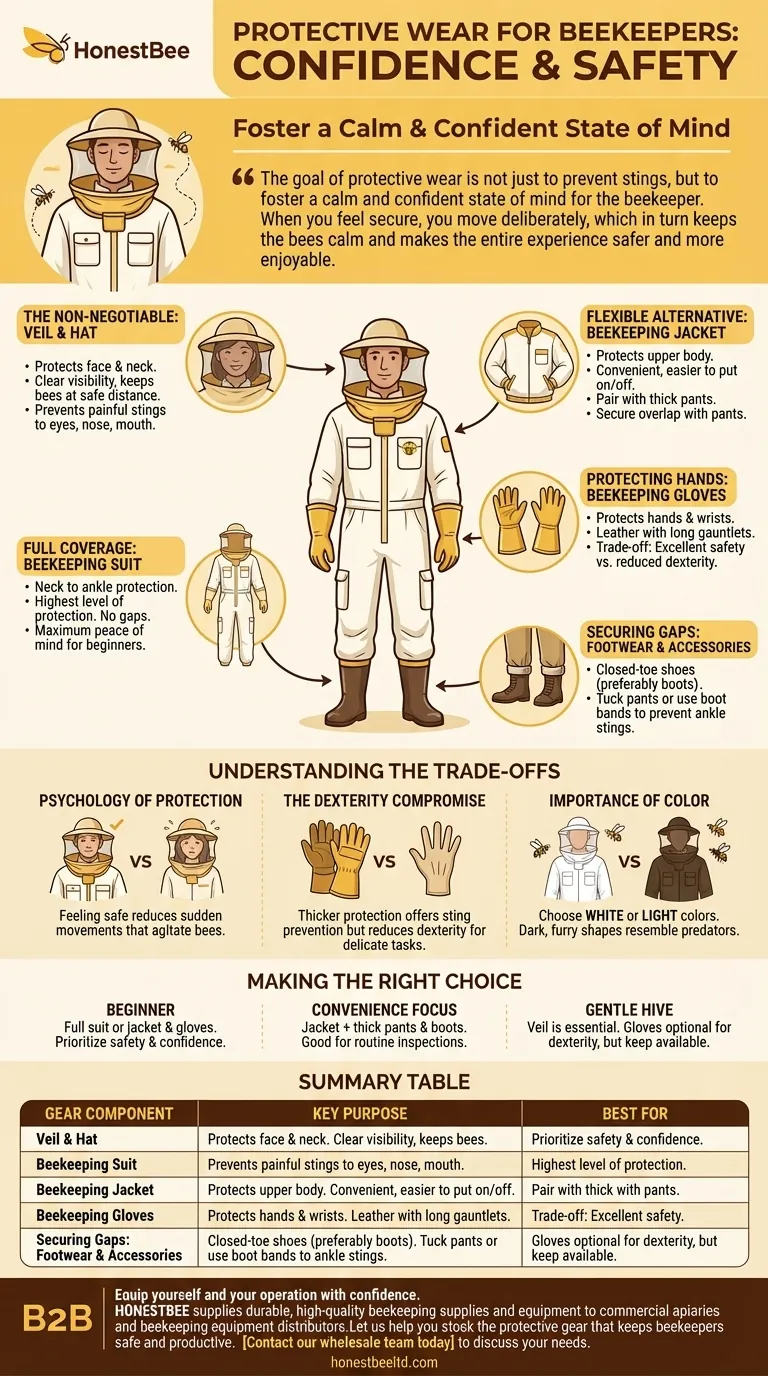At a minimum, beekeepers should wear a specialized hat and veil to protect the face and neck from stings. For more comprehensive safety, this is combined with a beekeeping suit or jacket, gloves, and closed-toe shoes. While some experienced beekeepers may use less, full protective coverage is the standard recommendation, especially for beginners.
The goal of protective wear is not just to prevent stings, but to foster a calm and confident state of mind for the beekeeper. When you feel secure, you move deliberately, which in turn keeps the bees calm and makes the entire experience safer and more enjoyable.

The Core Components of Beekeeper Protection
Effective protective gear creates a complete barrier between you and the bees. Each component serves a specific purpose, and understanding them allows you to choose the right level of protection for your needs.
The Non-Negotiable: The Veil and Hat
The single most critical piece of equipment is the veil. Stings to the face, particularly around the eyes, nose, and mouth, are uniquely painful and dangerous.
A quality veil provides clear visibility while keeping bees at a safe distance from your skin. It is almost always sold attached to a helmet or hat, or integrated directly into a jacket or suit.
Full Coverage: The Beekeeping Suit
A full beekeeping suit is a single coverall that protects you from neck to ankle. Most suits have a veil and hat integrated into the design, which can be zipped on or off.
This option offers the highest level of protection, ensuring there are no gaps between a jacket and pants where bees could potentially enter. It provides maximum peace of mind.
A Flexible Alternative: The Beekeeping Jacket
A beekeeping jacket protects the entire upper body and typically includes an integrated veil. It is a popular choice for its convenience and is easier to put on and take off than a full suit.
Jackets are typically paired with thick, sturdy pants like heavy jeans or cotton work pants. The key is ensuring a secure overlap between the bottom of the jacket and the top of your pants.
Protecting Your Hands: Beekeeping Gloves
Gloves protect your hands and wrists, which are in constant close contact with the hive. They are typically made of leather, often with long gauntlets extending up the forearm for added protection.
While gloves provide excellent safety, they can reduce dexterity. Some beekeepers use thinner nitrile or latex gloves for more delicate tasks, accepting a trade-off between sensitivity and protection.
Securing the Gaps: Footwear and Accessories
Your ankles are a common target for bees. Always wear closed-toe shoes, preferably over-the-ankle boots. Tucking your pants into your boots or using elastic boot bands creates a secure seal.
Understanding the Trade-offs
Choosing gear isn't just about buying the most expensive option; it's about balancing safety, comfort, and practicality for your specific situation.
The Psychology of Protection
Feeling safe is paramount. A new beekeeper who is worried about being stung is more likely to make sudden, jerky movements, which can agitate a hive.
Full protection allows you to move with calm, deliberate confidence. This predictable behavior is less threatening to the bees and significantly reduces the likelihood of defensive stinging.
The Dexterity Compromise
There is an inherent trade-off between the thickness of your protection and your ability to feel what you're doing.
Thick leather gloves and multi-layer suits offer maximum sting prevention but can feel cumbersome. As you gain experience, you may find that you prefer slightly less protection in exchange for greater dexterity when handling delicate frames of brood and honey.
The Importance of Color
Always choose protective wear in white or other light colors. Bees are naturally defensive against dark, furry shapes that resemble their natural predators, such as bears or skunks. Wearing light-colored clothing makes you appear less threatening.
Making the Right Choice for Your Goal
Your ideal setup depends on your experience level and comfort with bees.
- If you are a beginner: Prioritize a full suit or, at a minimum, a high-quality jacket with an integrated veil and a good pair of gloves. The confidence gained from feeling fully protected is invaluable.
- If your primary focus is convenience: A beekeeping jacket paired with thick jeans and boots is a practical and popular combination that offers excellent protection for routine inspections.
- If you are working with a known gentle hive: Even with the calmest bees, always wear a veil. Experienced keepers may forgo gloves for better dexterity, but they always have them available if the colony's mood changes.
Ultimately, the right protective gear empowers you to work with your bees safely and effectively.
Summary Table:
| Gear Component | Key Purpose | Best For |
|---|---|---|
| Veil & Hat | Protects face, eyes, and neck from stings. | All beekeepers, non-negotiable. |
| Full Suit | Maximum protection from neck to ankle. | Beginners and for maximum safety. |
| Beekeeping Jacket | Protects upper body; convenient and flexible. | Routine inspections and convenience. |
| Gloves | Protects hands and wrists during hive handling. | All beekeepers; dexterity trade-off. |
| Closed-Toe Shoes/Boots | Prevents stings to ankles and feet. | Essential for all hive work. |
Equip yourself and your operation with confidence. HONESTBEE supplies durable, high-quality beekeeping supplies and equipment to commercial apiaries and beekeeping equipment distributors through our wholesale-focused operations. Let us help you stock the protective gear that keeps beekeepers safe and productive. Contact our wholesale team today to discuss your needs.
Visual Guide

Related Products
- Beekeeping Gloves Goatskin Leather with Long Cotton Sleeve for Beekeepers
- Goatskin Leather Beekeeper Gloves with Vent Long Sleeve for Beekeeping Honey Bee Sting Proof Protection
- Mesh Ventilated 3 Layer Goatskin Beekeepers Gloves for Beekeeping
- Goat Skin Leather Bee Sting Proof Beekeeping Gloves with Canvas Sleeve
- Professional Galvanized Hive Strap with Secure Locking Buckle for Beekeeping
People Also Ask
- What should beekeepers consider regarding the fit of beekeeping gloves? Achieve Safety and Dexterity
- What are the arguments for and against using gloves in beekeeping? Balancing Protection and Dexterity
- What are the advantages of goatskin leather gloves for beekeeping? Superior Sting Protection for Your Apiary
- What is the difference between cleaning cow leather and goat leather beekeeping gloves? Tailor Your Care for Longevity
- Why do some experienced beekeepers choose not to wear gloves? For Superior Dexterity & Hive Welfare



















